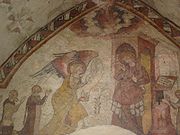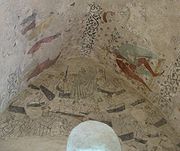
Fisherman's Chapel
Encyclopedia

Chapel
A chapel is a building used by Christians as a place of fellowship and worship. It may be part of a larger structure or complex, such as a church, college, hospital, palace, prison or funeral home, located on board a military or commercial ship, or it may be an entirely free-standing building,...
located beside St Brelade's Church
St Brelade's Church
St Brelade's Church is one of the twelve ancient parish churches in the island of Jersey; it is sited on the west of the island in the parish of St Brelade, in the south-west corner of St Brelade's Bay...
in St Brelade
Saint Brélade, Jersey
Saint Brélade is one of the twelve parishes of the Bailiwick of Jersey. Its population is around 9,560, and it occupies the southwestern part of the island. It is the only parish to border only one other parish, St. Peter...
, Jersey
Jersey
Jersey, officially the Bailiwick of Jersey is a British Crown Dependency off the coast of Normandy, France. As well as the island of Jersey itself, the bailiwick includes two groups of small islands that are no longer permanently inhabited, the Minquiers and Écréhous, and the Pierres de Lecq and...
, by the shore at the western end of St Brelade's Bay.
History
Only a few monastic chapels survived the destruction of over fifty others at the hands of the ReformersProtestant Reformation
The Protestant Reformation was a 16th-century split within Western Christianity initiated by Martin Luther, John Calvin and other early Protestants. The efforts of the self-described "reformers", who objected to the doctrines, rituals and ecclesiastical structure of the Roman Catholic Church, led...
in the 16th century. This is one of the few remaining with the exception of some Manorial Chapels, and those at La Hougue Bie
La Hougue Bie
La Hougue Bie is a historic site in the Parish of Grouville, Jersey. Hougue is a Jèrriais/Norman language word meaning a "mound" and comes from the Old Norse word haugr. Bie is of uncertain origin...
.
The name of the chapel is the Chapelle-ès-Pêcheurs, and it was original thought to be associated with the fishing
Fishing
Fishing is the activity of trying to catch wild fish. Fish are normally caught in the wild. Techniques for catching fish include hand gathering, spearing, netting, angling and trapping....
guilds existing in the Island . More convincingly, Warwick Rodwell
Warwick Rodwell
Dr Warwick Rodwell is an author, archaeologist, architectural historian and academic. In 1980, he published the standard textbook on church archaeology. He is a fellow of the Society of Antiquaries of London and of the Royal Historical Society.-Career:...
has suggested that "pêcheurs" (fishermen) is a corruption of " pécheurs" (sin
Sin
In religion, sin is the violation or deviation of an eternal divine law or standard. The term sin may also refer to the state of having committed such a violation. Christians believe the moral code of conduct is decreed by God In religion, sin (also called peccancy) is the violation or deviation...
ners); this agrees with his archaeological investigations which show the chapel to have been a "chantry
Chantry
Chantry is the English term for a fund established to pay for a priest to celebrate sung Masses for a specified purpose, generally for the soul of the deceased donor. Chantries were endowed with lands given by donors, the income from which maintained the chantry priest...
chapel", i.e. a chapel funded by a local family to say masses for the souls of the dead. There is no evidence of "fishing guilds".
The walls of this ancient chapel are reputed to date from the middle of the 6th century; some authorities give a later date.
The archaeological work done by Warwick Rodwell place the date of the chapel well after the construction of the main Parish church; because it is smaller, and has not later architectural accretions, it has a more ancient appearance, but this is in fact superficial. However, Rodwell suggests that a primitive wooden structure may have existed on this site as the first "St Brelade's Church"; this was replaced by the core of the present church in stone, with a site better suited for expansion, the first being used for worship while the second was being built. The wooden structure was then rebuilt as a secondary focus of worship, and later taken over as a Chantry chapel.
The material used in the building is the same as was used in the Parish Church: limpet
Limpet
Limpet is a common name for a number of different kinds of saltwater and freshwater snails ; it is applied to those snails that have a simple shell which is more or less conical in shape, and either is not spirally coiled, or appears not to be coiled in the adult snails.The name limpet is most...
shells crushed and dissolved with boiling sea-water. The mode of procedure was as follows : they first erected their walling, cased the same on all sides, and then poured the liquid lime-mortar into the wall-work.
The stone roof was raised in the 14th century. The monks of that period evidently found the roof too low and squat for wall paintings. These were discovered in 1918. After a severe storm, colour was revealed on the ceiling and a picture of the "Assumption
Assumption of Mary
According to the belief of Christians of the Roman Catholic Church, Eastern Orthodoxy, Oriental Orthodoxy, and parts of the Anglican Communion and Continuing Anglicanism, the Assumption of Mary was the bodily taking up of the Virgin Mary into Heaven at the end of her life...
" was seen, but in a damaged condition. But underneath the plaster was found another painting, 'The Annunciation
Annunciation
The Annunciation, also referred to as the Annunciation to the Blessed Virgin Mary or Annunciation of the Lord, is the Christian celebration of the announcement by the angel Gabriel to Virgin Mary, that she would conceive and become the mother of Jesus the Son of God. Gabriel told Mary to name her...
", of about 1310-1315 A.D. At the foot of this painting is seen fourteen figures, supposedly members of an old Jersey family, the head of which had paid for this painting.
The floor was restored to its earlier level in the 1980s to the Mediaeval level, and the "low, squat" aspect of the chapel which appears in early photographs is now gone, as the proper proportions can be seen.

Magi
Magi is a term, used since at least the 4th century BC, to denote a follower of Zoroaster, or rather, a follower of what the Hellenistic world associated Zoroaster with, which...
, with the name " Melchior
Melchior
Melchior is the name given in later legend to one of the Magi appearing in the Gospel of Matthew. It may also refer to:-First name:* Melchior Anderegg , Swiss mountain guide.* Melchior Berri , Swiss architect.* Melchior Broederlam Melchior is the name given in later legend to one of the Magi...
" above it, and close by another of the Wise Men bearing the inscription "les Mages". Between the Wise Men, the body and legs of a chain-mailed soldier is quite distinct.
On the west wall the subject is the " Resurrection
Resurrection
Resurrection refers to the literal coming back to life of the biologically dead. It is used both with respect to particular individuals or the belief in a General Resurrection of the dead at the end of the world. The General Resurrection is featured prominently in Jewish, Christian, and Muslim...
" and the "Last Judgement". Over the north door is a picture of Herodes Roy—King Herod ; close by is another: " The Scourging of Christ ". On the North ceiling over the door is a picture of our Lord " Riding upon an Ass " ; close by is a picture of a Roman soldier. On the south ceiling in the little Chancel, portions of Adam and Eve
Adam and Eve
Adam and Eve were, according to the Genesis creation narratives, the first human couple to inhabit Earth, created by YHWH, the God of the ancient Hebrews...
and the children are to be seen.
Early histories of the Parish Church of St Brelade made a mistaken identification with Saint Brendan which is undoubtedly wrong. Saint Brelade
Brelade
Branwalator or Breward, also referred to as Branwalader, was a British saint saint whose relics lay at Milton Abbas in Dorset and Branscombe in Devon. Believed to come from Brittany, he also gives his name to the parish of Saint Brélade, Jersey. "Brelade" is a corruption of "Branwalader"...
was also known as Saint Branwalader, and has no connection with St Brendan. However, as a result of this the stained glass windows in the Fisherman's Chapel portray scenes from the life of Saint Brendan.

